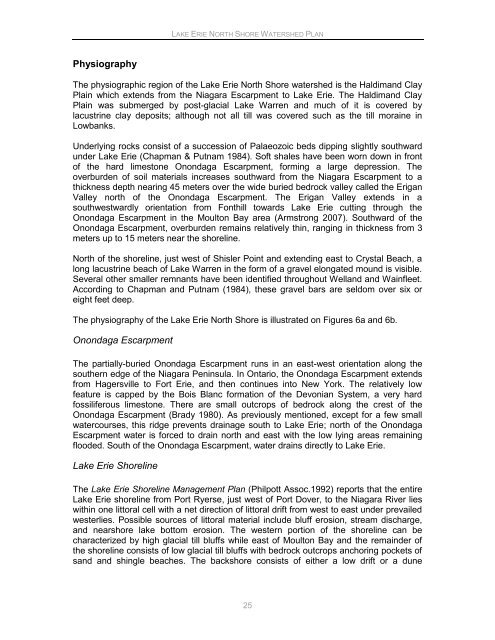Lake Erie North Shore Watershed Plan - Niagara Peninsula ...
Lake Erie North Shore Watershed Plan - Niagara Peninsula ...
Lake Erie North Shore Watershed Plan - Niagara Peninsula ...
You also want an ePaper? Increase the reach of your titles
YUMPU automatically turns print PDFs into web optimized ePapers that Google loves.
LAKE ERIE NORTH SHORE WATERSHED PLAN<br />
Physiography<br />
The physiographic region of the <strong>Lake</strong> <strong>Erie</strong> <strong>North</strong> <strong>Shore</strong> watershed is the Haldimand Clay<br />
Plain which extends from the <strong>Niagara</strong> Escarpment to <strong>Lake</strong> <strong>Erie</strong>. The Haldimand Clay<br />
Plain was submerged by post-glacial <strong>Lake</strong> Warren and much of it is covered by<br />
lacustrine clay deposits; although not all till was covered such as the till moraine in<br />
Lowbanks.<br />
Underlying rocks consist of a succession of Palaeozoic beds dipping slightly southward<br />
under <strong>Lake</strong> <strong>Erie</strong> (Chapman & Putnam 1984). Soft shales have been worn down in front<br />
of the hard limestone Onondaga Escarpment, forming a large depression. The<br />
overburden of soil materials increases southward from the <strong>Niagara</strong> Escarpment to a<br />
thickness depth nearing 45 meters over the wide buried bedrock valley called the Erigan<br />
Valley north of the Onondaga Escarpment. The Erigan Valley extends in a<br />
southwestwardly orientation from Fonthill towards <strong>Lake</strong> <strong>Erie</strong> cutting through the<br />
Onondaga Escarpment in the Moulton Bay area (Armstrong 2007). Southward of the<br />
Onondaga Escarpment, overburden remains relatively thin, ranging in thickness from 3<br />
meters up to 15 meters near the shoreline.<br />
<strong>North</strong> of the shoreline, just west of Shisler Point and extending east to Crystal Beach, a<br />
long lacustrine beach of <strong>Lake</strong> Warren in the form of a gravel elongated mound is visible.<br />
Several other smaller remnants have been identified throughout Welland and Wainfleet.<br />
According to Chapman and Putnam (1984), these gravel bars are seldom over six or<br />
eight feet deep.<br />
The physiography of the <strong>Lake</strong> <strong>Erie</strong> <strong>North</strong> <strong>Shore</strong> is illustrated on Figures 6a and 6b.<br />
Onondaga Escarpment<br />
The partially-buried Onondaga Escarpment runs in an east-west orientation along the<br />
southern edge of the <strong>Niagara</strong> <strong>Peninsula</strong>. In Ontario, the Onondaga Escarpment extends<br />
from Hagersville to Fort <strong>Erie</strong>, and then continues into New York. The relatively low<br />
feature is capped by the Bois Blanc formation of the Devonian System, a very hard<br />
fossiliferous limestone. There are small outcrops of bedrock along the crest of the<br />
Onondaga Escarpment (Brady 1980). As previously mentioned, except for a few small<br />
watercourses, this ridge prevents drainage south to <strong>Lake</strong> <strong>Erie</strong>; north of the Onondaga<br />
Escarpment water is forced to drain north and east with the low lying areas remaining<br />
flooded. South of the Onondaga Escarpment, water drains directly to <strong>Lake</strong> <strong>Erie</strong>.<br />
<strong>Lake</strong> <strong>Erie</strong> <strong>Shore</strong>line<br />
The <strong>Lake</strong> <strong>Erie</strong> <strong>Shore</strong>line Management <strong>Plan</strong> (Philpott Assoc.1992) reports that the entire<br />
<strong>Lake</strong> <strong>Erie</strong> shoreline from Port Ryerse, just west of Port Dover, to the <strong>Niagara</strong> River lies<br />
within one littoral cell with a net direction of littoral drift from west to east under prevailed<br />
westerlies. Possible sources of littoral material include bluff erosion, stream discharge,<br />
and nearshore lake bottom erosion. The western portion of the shoreline can be<br />
characterized by high glacial till bluffs while east of Moulton Bay and the remainder of<br />
the shoreline consists of low glacial till bluffs with bedrock outcrops anchoring pockets of<br />
sand and shingle beaches. The backshore consists of either a low drift or a dune<br />
25
















